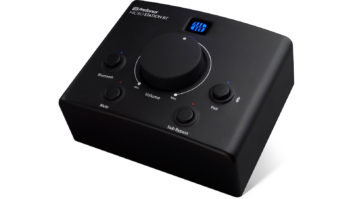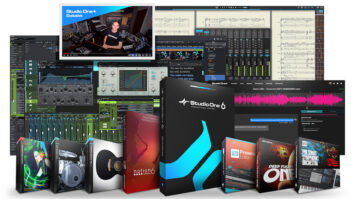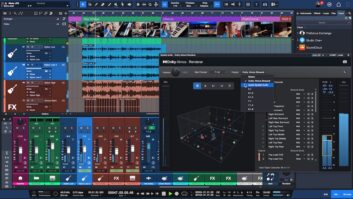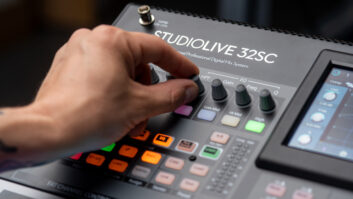
If there’s anything that the small to medium DAW-based studio can use, it’s more desktop space. PreSonus’ Central Station accomplishes this and provides metering, talkback, footswitch control and other features found in a console’s center section.
Central Station is a moderately priced monitoring solution for 2-channel stereo setups, featuring an excellent design and a number of conveniences. It also has an optional wired remote. The main unit is a 1U 5.5-inch-deep box with three pairs of analog inputs, and optical and RCA stereo S/PDIF digital ins. Two of the analog ins are ¼-inch TRS and the third one — the aux input — is RCA and has a trim pot.
There are two output paths in Central Station, each of which can be switched independently to any single input pair. The Cue output path feeds its own TRS outputs and the onboard headphone amp, which has two jacks. The built-in talkback mic or optional external mic, either of which can be triggered by a footpedal, feed this path.
The main output path feeds its own pair of outputs, as well as the A, B and C pairs of “speaker” outs (which are actually amplifier outs). A and B can’t be active simultaneously, but C can be active at the same time as A or B as it’s intended for a subwoofer.
QUALITY SIGNAL PATH
The analog signal path is passive throughout, but Central Station’s D/A converters, lights, relay switches, headphone amp, talkback mic and meters are powered by a relatively hefty (3.5×2×2.5-inch) in-line supply. All but the two buttons that affect the meters are triggers for relays; they’re not actual switches with audio passing through them.
The above-mentioned meter is an easy-to-read 3-inch, 30-stage stereo LED peak-reading meter. It holds the peak indication until you push the Clear Peak button, but an undocumented feature lets you change this to momentary peak hold.
It’s easy to calibrate the meter to any desired level within a ±12dB range: Press the Calibrate button and send it a signal (most likely a 1kHz sine wave) and that signal’s level becomes -18 dBFS/0 dB on the meter. There are also pairs of trims for matching the levels of different speakers and correcting left/right imbalances.
REMOTE ACCESS
The optional wired remote — which I consider mandatory — attaches to the main unit by a 6-foot 15-pin cable. This unit is well-designed, with its lighted buttons, ergonomic layout and compact case (roughly 5½ inches square) that won’t slide around the desktop. Just about all of the main signal path’s controls, plus a duplicate talkback mic, are included.
VOLUME CONTROL
To see how closely Central Station tracks between channels at various levels, I ran sine wave recordings through it and looked at the results in Pro Tools. Until you get down to the whisper range, the two channels were never more than 0.4 dB apart, usually less.
That was close enough for there to be no discernible image shift, and well within range of what one would expect from any standard stereo-ganged potentiometer. The only way to improve upon that (and to ensure that the level is precisely repeatable) would be to replace the pot with a stepped attenuator using a resistor array. Those parts are exorbitantly expensive and generally found only in units costing many times Central Station’s price.
THE DIGITAL SECTION
The onboard stereo DAC boasts an impressive 117dB dynamic range spec. There’s no word clock input; the unit automatically locks to any standard sample rate between 44.1 and 192 kHz.
I compared Central Station’s DAC at 24-bit/44.1 kHz and/or 96 kHz to the built-in DACs in the Panasonic DAT mixer, Digidesign 24-bit ADAT Bridge and the MOTU 1224 (at 44.1), the Waves L2 (at 96k) and the Apogee Mini-DAC (44.1 and 96), and it sounded subjectively as good or better. Central Station’s conversion is not quite up to the level of a higher-end Apogee DAC (acoustic guitar strings sound about 20 minutes newer through the Apogee, for example), but my ears were perfectly content listening to Central Station’s converters.
HOW DOES IT MEASURE UP?
One scratchy output on the review unit aside (most likely due to a dirty switch somewhere), Central Station’s build quality seems fine. The relay switches don’t glitch when activated, and combined with the passive circuitry, this makes Central Station an excellent unit for A/B comparisons.
This review coincided with an experiment to ditch the digital mixer in my MIDI-plus-overdubs studio in favor of a Pro Tools and MOTU PCI-424 — based setup. Contrary to my apprehensions, living with Central Station’s easy ergonomics turned out to be extremely convenient; having its non-invasive remote control constantly within reach was ideal.
At $699 for the basic unit and $199 for the remote, Central Station does its job at a fair price — without being obtrusive, either sonically or physically.
PreSonus, 225/216-7887, www.presonus.com.
Nick Batzdorf is a music and audio technology writer, composer and engineer/producer in Los Angeles.






